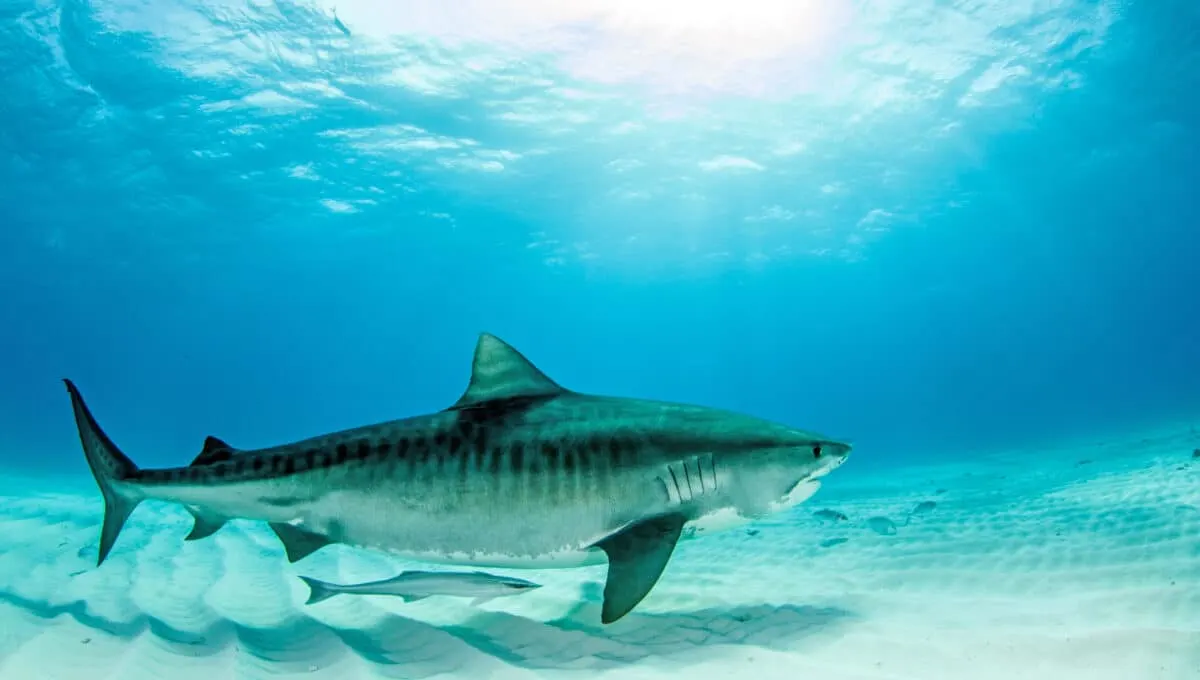Experience a spine-chilling moment as we delve into the close encounter between a Tiger Shark and a diver on a boat. Witness the heart-stopping event when the Tiger Shark nearly grabs the diver, exploring the factors contributing to this intense interaction.
Delve into the world of apex predators, human-wildlife coexistence, and the importance of understanding shark behavior for safer underwater experiences.
See the full video below!
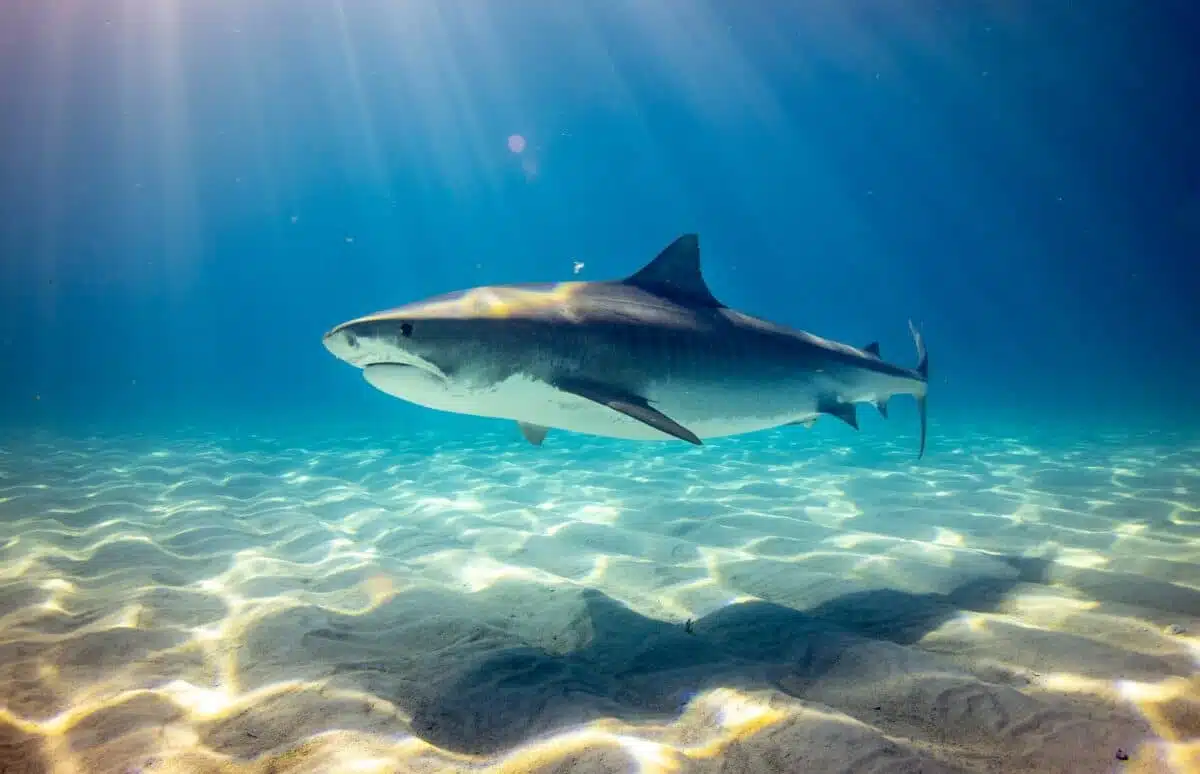
Want to jump ahead? Click below
The Tiger Shark: Characteristics And Habitat Of Tiger Sharks

Tiger Sharks, or Galeocerdo cuvier as their scientific name suggests, are among the biggest hunters in the ocean. They stand out with their unique striped pattern reminiscent of tigers.
These remarkable creatures can reach impressive lengths of up to 16 feet and weigh a whopping 1,400 pounds. They thrive in tropical and subtropical regions, making their presence known in numerous locations.
They prefer shallow coastal waters, but they are also known to venture into the open ocean and can be found at depths of up to 2,600 feet.
Predatory Behavior
Tiger Sharks hold the title of being apex predators, which essentially means they reign supreme at the very top of their respective food chains within their ecosystems.
With a highly developed sense of smell, they can detect prey from miles away and are known for being opportunistic feeders. They eat prey, from smaller fish and crustaceans to sea turtles, dolphins, and sharks.
One of the most unique characteristics of Tiger Sharks is their ability to swallow prey whole. Their jaws are designed to detach and protrude forward, allowing them to eat prey much larger than their head.
Tiger Sharks In Marine Ecosystems
Tiger Sharks are incredibly important for keeping marine ecosystems in check. Being top predators, they play a vital role in controlling the population of their prey and stopping herbivores from munching up the entire ecosystem.
They also play an important role in nutrient cycling, as their fecal matter provides necessary nutrients for smaller organisms in the ecosystem.
Overfishing and habitat destruction have heavily impacted Tiger Sharks despite their important role in marine ecosystems.
The Close Encounter Between The Tiger Shark And The Diver
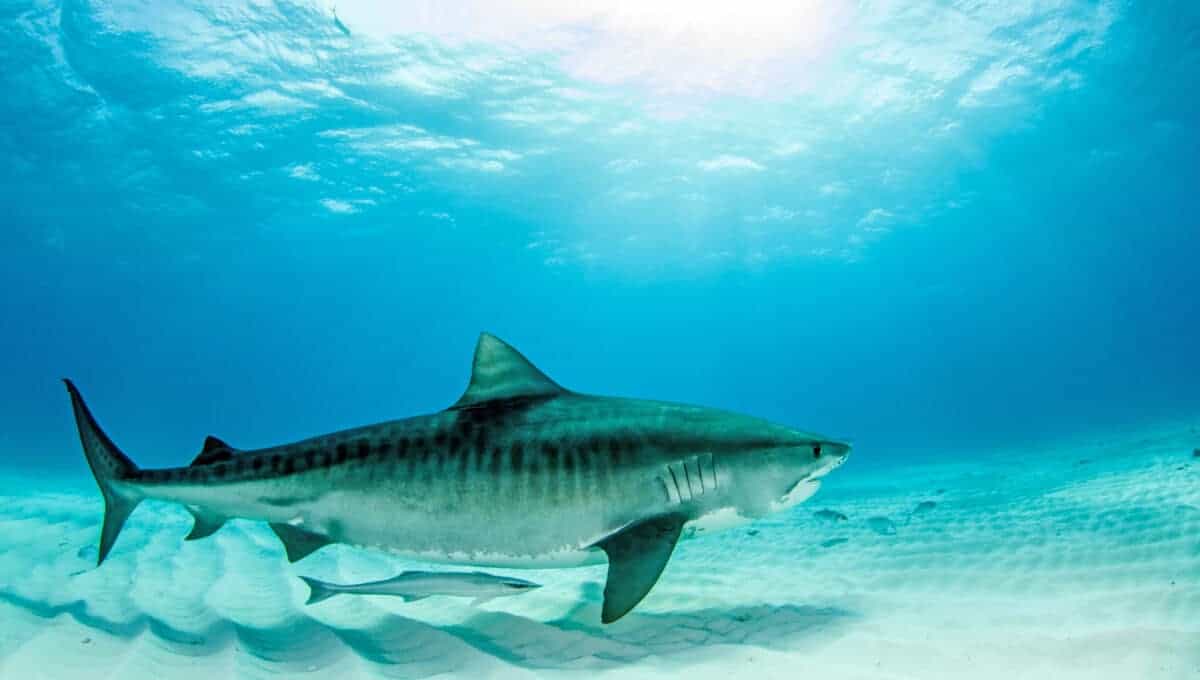
The close encounter between the Tiger Shark and the diver occurred when the latter explored the underwater environment around the boat.
Suddenly, the Tiger Shark appeared and started swimming very close to the diver, causing panic. The diver, equipped with proper safety gear, tried to maintain composure and stay as still as possible to avoid sudden movements that could trigger the shark’s aggression.
However, the Tiger Shark became increasingly curious and began to approach the diver at a rapid speed, nearly grabbing him. With lightning reflexes, the diver managed to swim away and scramble back onto the boat.
Watch a similar scenario happen and promise yourself to never jump into the ocean!
- Factors That May Have Contributed To The Close Encounter
Several factors may have contributed to the close encounter with the Tiger Shark.
- Firstly, the Tiger Shark is a curious and aggressive apex predator.
- Secondly, the diver strayed too close to the shark’s habitat, which could have triggered its defensive instincts.
- Environmental factors such as wind, currents, and water temperature could have influenced the shark’s behavior.
- Impact On The Diver And The Boat Crew
The near-grab incident with the Tiger Shark significantly impacted both the diver and the boat crew. The diver experienced a moment of sheer terror, which could have led to long-lasting psychological effects.
Plus, the crew onboard also experienced a sense of shock and fear as they had witnessed the close encounter at close quarters.
Also, the boat crew would have to review their safety protocols to ensure that future diving experiences were carried out with the utmost care and caution. Being aware of the factors that contributed to the incident would enable the crew to take the necessary steps to minimize the risk of similar incidents occurring in the future.
Underwater Safety And Understanding Shark Behavior
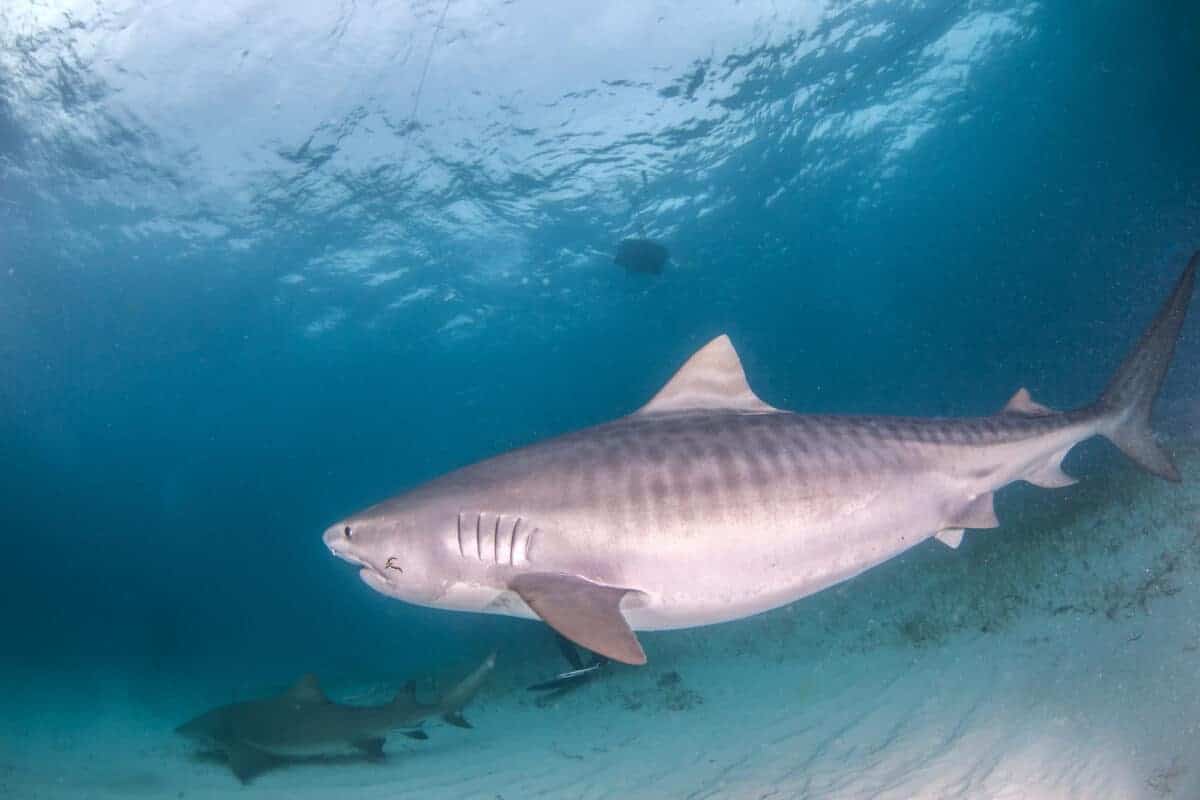
Exploring the underwater world is a thrilling experience that thousands of people enjoy. However, remembering that we are sharing the ocean with a vast array of marine life, including apex predators like sharks, is crucial.
Therefore, it is essential to understand their behavior and take proper safety precautions to minimize the risk of close encounters.
Importance Of Proper Safety Protocols For Divers And Water Enthusiasts
Diving and snorkeling are activities that require specific equipment and training. Following the proper safety protocols and guidelines is vital to ensure a successful and safe experience. Before diving, it is crucial to thoroughly check the equipment and ensure it is in good working order.
It is also essential to understand the depth limitations, diving time, and proper decompression procedures to avoid injuries and a sudden shift in the body’s functions. Furthermore, water enthusiasts must have the necessary certifications, training, and experience before venturing into the ocean’s open waters.
Ways To Minimize The Risk Of Close Encounters With Sharks
Sharks have a reputation for being aggressive and dangerous. However, they are not naturally inclined to attack humans. Nevertheless, it is best to minimize the risk of close encounters by avoiding areas where sharks are known to feed or breed.
For instance, it’s best to avoid swimming in murky water or around fishing boats where sharks may perceive humans as a threat. We must also follow the proper safety protocols for disposing of food waste and fish scraps to avoid attracting sharks to populated areas.
Significance Of Understanding Shark Behavior For Human-Wildlife Coexistence
Understanding shark behavior is essential for coexistence. Sharks are crucial in maintaining a healthy ocean ecosystem and should not be feared or eliminated. Instead, we must learn how to coexist with them peacefully by respecting their territory and limiting our impact on their world.
It means avoiding human activities that disturb or harm their natural habitat and behavioral patterns. By understanding their behavior, we can work towards creating awareness and developing strategies for safe and peaceful coexistence with these incredible creatures.
Key Points
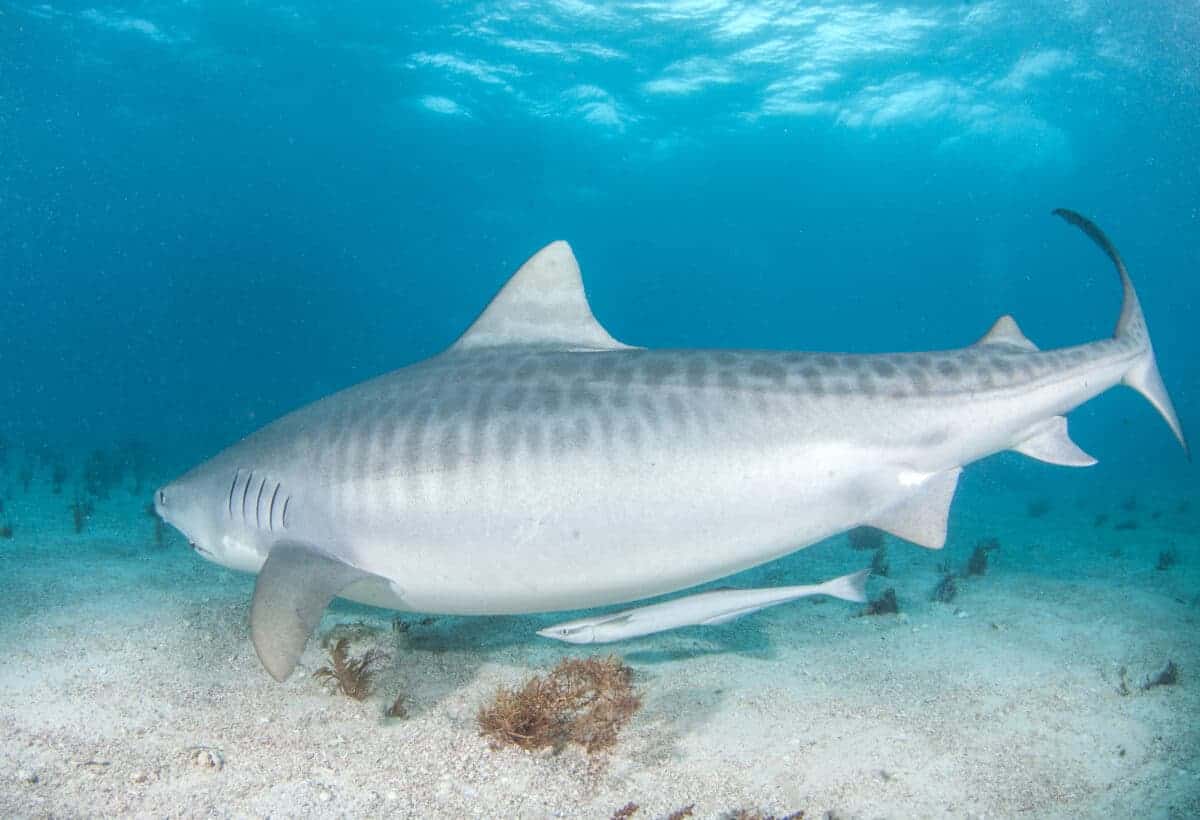
| The close encounter between the Tiger Shark and the diver occurred when the latter explored the underwater environment around the boat. |
| Tiger Sharks are incredibly important for keeping marine ecosystems in check. Being top predators, they play a vital role in controlling the population of their prey and stopping herbivores from munching up the entire ecosystem. |
| Environmental factors such as wind, currents, and water temperature could have influenced the shark’s behavior. |
| Understanding shark behavior is essential for human-wildlife coexistence. Sharks are crucial in maintaining a healthy ocean ecosystem and should not be feared or eliminated. |
| The boat crew would have to review their safety protocols to ensure that future diving experiences were carried out with the utmost care and caution. |
Wrapping Up with Tiger Shark Who Almost Grabs Diver from Boat
The near-grab incident between a Tiger Shark and a diver highlights the awe-inspiring power and unpredictability of marine wildlife encounters. This captivating event serves as a reminder of the need for caution and respect when exploring the underwater world.
Understanding shark behavior and implementing proper safety measures are crucial for ensuring harmonious coexistence between humans and apex predators. By appreciating the delicate balance of marine ecosystems, we can cultivate a greater appreciation for these magnificent creatures and work toward their conservation.
Thanks for following along with me! I hope you enjoyed reading about a topic that intrigues me.
Next up is ~
- Bald Eagle Family Expand Their Nest In California - April 24, 2024
- Firefighter Saves Abandoned Kittens Found Cuddling In Hoses - April 24, 2024
- Dolphins Get High Playing Catch With A Pufferfish - April 24, 2024

